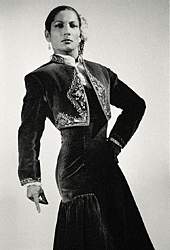


In 1963 Carmen Amaya played the protagonist in the Spanish film “Los Tarantos.” Not only was the film set in her native city but it was filmed specifically in the shanty neighborhoods of Somorrostro and Montjuich. Five years later, her widower Juan Antonio Agüero, married the founder of the Tablao de Carmen.

A few hours after the ceremony, both were back to performing on stage. Carmen and “Juan” Antonio Agüero, a quiet weddingĬarmen married Juan Antonio Agüero, a guitarist and member of her company, surrounded only close friends in a service held early in the morning in Barcelona. Here Carmen filmed many films, recorded many discs and even caught the attention of President Roosevelt when she danced at the White House. This shift was an opportunity to later travel to America, where Carmen spent eleven years conquering the renowned theatres of the United States, Argentina, Uruguay, Bolivia, Brazil and Mexico. One of Carmen’s biographies, “Biografía de Carmen Amaya, célebre bailaora de flamenco en Barcelona”4 tells that with the start of the Spanish Civil War in 1936, Carmen and her company left Spain for Portugal. Carmen, the international celebrityĪfter performing all over Spain and several times in Paris, Carmen was quick to win Europe’s heart.

“Those in charge of maintaining protocol in the royal house asked Carmen to address the monarch as ‘your Majesty.’ As soon as the head of state appeared, the girl took a step forward and confidently said, ‘this one’s for you Mister King!’… In that moment, an unbreakable friendship formed between the king, who was later stripped of his throne, and the queen of dance…”3 tells El Mundo magazine, in an article titled “The Hidden Memories of Carmen Amaya.” Half a century later, in that same pavillion, the Poble Espanyol, the Tablao de Carmen was founded in homage to the great flamenco dancer. In 1929, when she was barely eleven years old, Carmen and her people performed in honour of King Alfonso XIII for the inauguration of Spain’s pavillion in the World Fair. Carmen, the young girl who dazzled the king of Spain Little by little contracts and shows started presenting themselves to Carmen in local theatres, with them came fame. Carmen began to develop her own style, dancing at all hours over the sandy beaches of Somorrostro and accompanying her father to bars and taverns to earn what she could. Her father, a flamenco guitarist known as “Chino,” would make her dance for hours on end while he corrected and directed her. It is a little-known fact that Carmen was self-taught, and her talents became apparent at the tender age of four. My first idea of movement and dance came from the rythm of the waves.”2. “My life and my artistry were born of the sea. Carmen, the dancing girl who learned from the sea. The most widely accepted date for Carmen’s birth is the 2nd of November, 1918, although for a long time this date was not confirmed. March, tells of the relevance of this neighborhood to Barcelona’s history. The book Somorrostro, mirades literàries1 by Enric H. Once a marginal shanty town located between the train tracks of the city and the sea, Somorrostro has since disappeared. Carmen of the SomorrostroĬarmen was born to gypsy parents of a humble background, and grew up in Somorrostro.
#CARMEN AMAYA FULL#
While many parts of her life are shrouded in mystery, Carmen’s biography is full of fascinating elements that are important to know in order to understand the footprint that Carmen has left in Spanish culture and in Barcelona. A sort of flamenco that can only come from the legacy of Catalonia’s incomparable artist, the gypsy dancer and singer, Carmen Amaya. El Tablao de Carmen, in the Poble Espanyol de Barcelona, offers the most genuine flamenco.


 0 kommentar(er)
0 kommentar(er)
